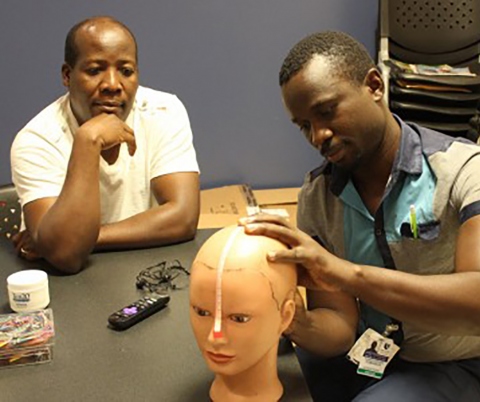November 7, 2020
Team profile by Antoinette Charles, Wyatt Gildea, Tyler Johnson, Colby Newson, Pratamesh Ramasubramanian and Olivia Ratliff

Project Background
The goal of our Bass Connections team is to mitigate the epilepsy treatment gap in Uganda by developing an enriched, visually engaging program for epilepsy education specific to the infrastructure and sociocultural context of Uganda. Although epilepsy is one of the most common neurological disorders in the world, in Uganda and other low- and middle-income countries, many patients do not receive care for this neurologic condition despite the fact that it is highly treatable.
Barriers to effective long-term care in Uganda include issues with affordability, lack of trust, crowded clinics that run out of medicines, cultural stigma and misunderstanding clouding public perception of the disease. Working with our partners at Makerere University in Uganda, our aim is to bolster the capacity and quality of care available at health care centers by developing and disseminating a comprehensive, effective and targeted epilepsy health care education curriculum. This curriculum will combine the baseline epilepsy care educational materials from the WHO’s Mental Health Gap Action Program (mhGAP) with regionally and culturally specific best practices unique to the Ugandan health care setting.
Our Methods
The team began by reviewing the findings from prior iterations of this project, which sought to understand the sociocultural context of epilepsy and its care in Uganda. We then systematically researched the existing mhGAP curriculum for epilepsy education, Uganda-specific treatment guidelines and referral flows, and published documents delineating location-specific medication stocks. We are considering improvements to the WHO module, including importing the Uganda prescribing guidelines, creating complex management scenarios and focusing on culturally sensitive communications to optimize engagement, adherence and outcomes. As we develop this material, we will engage Ugandan neurologists, psychiatrists and physicians who specialize in epilepsy care, as well as Duke epileptologists.
International Partnerships During a Global Pandemic
The coronavirus pandemic has forced our team to adapt our research methods and ways of operating. We have turned to Zoom to meet as a team, as well as to communicate with our colleagues in Uganda. Zoom has proved to be time- and cost-efficient, allowing us to connect across the world at a fraction of our previous expense. While the initial transition from in-person to virtual was necessarily uncomfortable – having lost the familiarity lent by physical proximity – our team has leaned into the change in methodology and even found ways to streamline our research practices to take advantage of technology.
What We’ve Learned So Far
Interviews with our Ugandan colleagues involve three separate stages: 1) interviews with clinicians to better understand their operational setting, priorities and best practices, with an emphasis on clinical care realities and communication; 2) review of module components; and 3) developing implementation plans for delivery of the program. Thus far, we have identified several essential cultural and regional components of epilepsy care to incorporate into our targeted curriculum: using metaphors to explain epilepsy, the role of traditional healers, and the clinic operational structure.
We have learned about different strategies providers use to explain epilepsy causation and to reduce shame, including the use of metaphors. For example, one physician likened epilepsy to a temporary power outage or load shedding, while another compared the disease to a scar on the brain that occasionally itches. These simple explanations serve as powerful tools to destigmatize the disease by providing patients with a framework to understand the underlying biological causes of epilepsy and challenge beliefs about supernatural or demonic causation.
Interviews also improved our understanding of the Ugandan healthcare landscape and epilepsy stakeholders. Along with physicians, traditional healers also often play an enormous role in patient health care. Yet, we have learned that physicians and traditional healers work independently and seldom collaborate. Such unilateral care creates a potential drug dilemma, where physicians are wary of prescribing anti-epileptic drugs due to the potential side effects that arise when drugs and traditional medicine are taken simultaneously.
Additionally, the interviews have taught us about Ugandan neurology and psychiatry clinics at the regional and national hospitals where specialized epilepsy care is provided. Providers stressed the importance of taking time to build rapport to facilitate sharing, which allows the provider to learn each patient’s story to inform the care approach. The clinical story is especially important in light of the absence of other diagnostic tools, such as EEG and MRI studies.
Moving Forward
As we work with our partners in Uganda to improve care for patients with epilepsy, the threads that fundamentally unite global health, medicine, education and technology are more apparent than ever. Applying our interdisciplinary education in this global context has taught us the value of our liberal arts education. As undergraduates and medical students, building a curriculum of this nature and scope is both an exceptional challenge and an enormous privilege.
Image: Christopher Komakech demonstrates how to place electrodes for an EEG exam, from Fighting Epilepsy in Uganda with Tools and Teamwork, Duke Global Health Institute website
